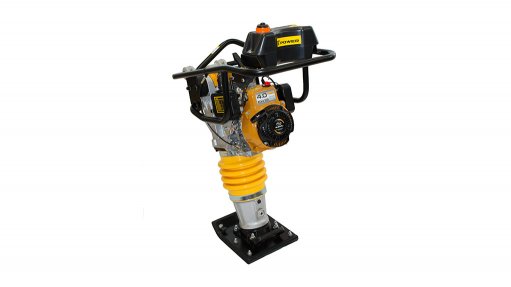
MARKET FAVOURITE A popular and reliable unit is the H-Power RM 75 tamping rammer, comprising the Robin Subaru EH12 engine that extends operating life
Since it was appointed the exclusive Southern Africa distributor of light construction equipment Power’s tamping rammers, vibratory rollers, concrete mixers, light towers and air-cooled engines in September 2014, engine, pumps and power products distributor Goscor Power Products has noted a doubling in sales of this range of products.
Chinese light construction equipment firm Anhui H-Power Machinery Company manufactures the H-Power product range.
Goscor Power Products MD Mark Bester tells Engineering News that customers cited product quality as a key part of their satisfaction with H-Power products.
The range comprises the H-Power rammers, rollers and concrete mixers, including the efficient, easy-to-manoeuvre concrete mixer that delivers significant production capacity.
He adds that, unlike most of the chain- or belt-driven vibratory rollers available on the market, the H-Power HR-RH800 vibratory roller features a fully hydraulic drive system that delivers exceptional compaction for all types of gravel and asphalt surfaces in large and confined areas.
Bester highlights, however, that the top-selling unit in the range is the H-Power tamping rammer. He further notes that the most popular and reliable rammer, the RM 75, comprises the Robin Subaru EH12 engine, which he believes is the most sought-after engine to power rammers and extend operating life.
“Goscor aims to supply about 300 units to local industry in the first quarter,” he says, highlighting the number of local infrastructure projects currently under way that require construction companies to lay copious amounts of piping and fibre-optic cables in trenches of several hundred kilometres. These trenches require backfilling and compaction using the rammers.
In light of this, Bester notes that the product needs to be robust. It also needs to ensure ease of operation. “H-Power’s superior product quality, as well as its extensive range, cemented our decision to offer these products to the local market.”
Rammer Features
The H-Power tamping rammer, while available in a four-stroke 2.9 kW Robin Subaru petrol engine power unit, is also available with a 2.8 kW diesel power source, with an optional trolley wheel that facilitates transportation.
Bester emphasises that, as H-Power’s equipment is tested specifically for the harsh, dry and dusty Southern Africa conditions to ensure optimum reliability, maximised uptime and low cost of ownership for the end-user, Anhui introduced several modifications to the H-Power tamping rammer for added reliability, safety, cost reduction and convenience.
“We have standardised Japanese NSK bearings so that they can be used in the rammer to extend its service life for the complete service life of the rammer,” says Bester, adding that Goscor also installed a German-manufactured bellow, which provides enhanced flexibility during operation and eliminates lubrication leaking, resulting in extended wear life.
As dust is also a key cause of engine failure, Goscor designed the rammer frame to facilitate access to the newly fitted snorkel-type air cleaner, which has a prefilter inside and on the Robin Subaru engine for dual air-cleaning functionality.
This cleaner ensures that the air passing through the engine is clean, with minimal sand particles or dust, he says, noting that this cleaner enables the rammer engines to last twice as long, compared with the life of other rammer engines.
Market Need
Bester highlights the market need for a high-quality medium-priced product, as several construction companies prefer to rent or hire equipment rather than invest capital by buying it.
“If the project spans a lengthy period, companies might consider an outright purchase, though they might prefer the rental route for short-term projects.”
He adds that some, more often than not, construction companies do not have the facilities to maintain these machines on site, whereas hire companies would send a mechanic to site to maintain the product on a daily basis.
Bester believes that companies’ preference for renting equipment could be attributed to the capital outlay of the requisite equipment, compared with rental costs, maintenance and theft.
Construction companies will, therefore, try to mitigate any risks by renting equipment from a company that can provide a good-quality, but well-priced machine, concludes Bester.